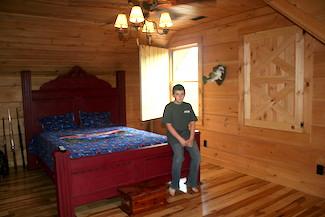Honest Abe Log Homes’ Livingston Plan was Modified to Create Family’s Log Cabin Forever Home
By Claudia Johnson, Director of Marketing, Honest Abe Log Homes

Ask Tanner Oakley anything about the construction of his family’s log house, and he’ll probably know the answer. Sounds reasonable since it is his house, right?
Tanner was just 10 years old (as seen above) when the home was built, but the precocious and mannered young man has experienced what few people, let alone children, in the 21st century ever will – the building of a log cabin.
“I was involved with every part,” said Tanner, whose parents Holly and Tim Oakley included him from the beginning. “I helped pick out the plans, and I helped clear the land.”
Tanner recalled rising early to spend long days working with his father to prepare the construction site, which is located on 17 acres of wooded property on Dale Hollow Lake in Tennessee.
“When we bought this land, we knew it needed a log cabin,” Holly said, adding that Tim’s brother had built an Honest Abe log home in 2008 only a few miles up the road. “We chose Honest Abe because of its location and also because of others who had dealt with them in the past and had good experiences. We were happy to support a local business.”
The Oakleys began working with Inez Price at Honest Abe Log Home’s National Headquarters in Moss, Tennessee, to create a home that fit into its natural surroundings and met the concerns of a modern family while capturing the feel of Tennessee’s early log homes. The Livingston Plan was selected, and the Oakleys’ choice of Honest Abe’s Genesis, square dovetailed logs created the traditional look they wanted.
“Inez was exceptional; she is such a joy to work with,” Holly said. “Inez was always available to answer questions and help in any way she could. She is one of many sweet people we met through working with Honest Abe.”
Honest Abe’s design department modified the Livingston plan’s open first floor to create the historic cabin atmosphere the Oakleys had imagined.
“A full wall was erected between the living room and dining room,” Holly said. “We added a pantry in the kitchen and moved the location of the refrigerator.”
Other modifications to the Livingston plan included changing the study to a spacious laundry room and adding a second closet in the master bedroom.
Builder Mike Strong served as contractor for erection of the log cabin, which has a 1,400-square-foot-basement, a main floor with 1,400 square feet and a second story with 800 square-feet.
“He was wonderful,” Holly said. “He did a great job, and we would highly recommend him.”
Tim said that he and Holly tried to use “local folks” whenever possible throughout the building process. “Everyone we worked with was professional and far exceeded our expectations from our electricians to our brick mason,” Tim said.
Holly and Tim said that they committed to making thought-filled decisions during construction to ensure that their home had quality construction, materials and fixtures that would last and that the finished home would be affordable to operate and maintain. They used one coat of Perma-Chink dark natural stain to keep the interior wood protected but light, while the exterior has two coats of Perma-Chink Dark Natural Stain and a gloss finish.
Many of the decisions made about the exterior of the 2,200 square-foot-home addressed the Oakleys’ goals.
“We really liked the dovetail corners and thought the flat shape of the logs would hold up to the elements better,” Holly said, explaining that for extra protection they added an eight-foot-wide porch that completely wraps around the home.
The Oakleys upgraded their log home package to include the optional Andersen windows, a decision Holly says was “definitely worth it.”
“The Andersen windows help with energy efficiency,” Holly said. “We have a central heat and air unit, but we heat with a Woodmaster wood furnace, which also heats our hot water. Our energy bills are very affordable.”
They replaced a traditional front door with a heavy oak tri-unit that includes a center door with a thick beveled and frosted oval window and matching rectangular side panel windows.
“We acted as our own GC to finish the cabin, which was very time consuming, but we price shopped and ordered a lot of things online, which saved us money and allowed us to pick out exactly what we wanted,” she said. “We tried to use products made in the USA as much as possible.”
The Oakleys chose prefinished hickory tongue and groove flooring in staggered widths, which they laid themselves. Tim pointed out that the job was not only labor intensive, it required looking at all the boards provided to determine an installation pattern that would not create excessively dark or light areas since the wood’s patterns and grains were visible through the natural finish.
“The fact we did most of the finishing gave us a great sense of pride in our home,” Tim said.
Finishing the home themselves offered another benefit far beyond the financial.
“I helped make some decisions with the finishing,” Tanner said. “I helped with painting and also helped my Dad with finishing the cabin.”
Tanner, who is homeschooled, said he learned how to drive nails and use a tape measure properly. He made all design and decorating choices for his room, and because he was included in trips to purchase supplies, he can competently discuss price differences in materials and why certain choices were made.
“I also got to pick out everything in the upstairs bathroom,” Tanner said.
He explained that he had a choice between traditional square tile or tile that looks like wood to use for flooring, so he chose the wood look.
“It was only 99 cents a square foot, so I thought ‘why not’,” he said.
He suggested the use of rocks for the interior of the showers in place of tile, and showers in both the master bath and the bath he shares with an older brother are covered in a special non-slip polished river stone made especially for use in the shower. His bowl-type sink was chosen because it looked like an intricate polished rock and is installed onto an antique washstand.
Tanner was enlisted to help create the loft railing, which Tim and Holly fashioned from chicken wire, planks and Honest Abe ceiling beams. To simulate the aged look of barn wood, Tanner explained that they placed steel wool in glass jars with apple cider vinegar and used the resulting residue from the rusted wool to stain the rails.
“I have always loved decorating with antiques, and a log home is perfect to showcase rustic antiques,” his mother said, adding that they found ideas on Pinterest, in magazines and other sources.
Throughout the house the Oakleys have displayed their antiques and heirlooms, from antique quilts and jugs to farm tools to Tim’s collection of turkey beards that decorate a beam in the master bedroom. The restored oval, enamel bathtub standing in the master bath sat in a barnyard for decades holding feed for animals.
Front porch steps are fashioned with rocks Tim and friends dismantled from the chimney of a house built by Holly’s great, great grandfather Alexander Ogletree and also occupied by her grandfather and father.
“It is so neat to bring that piece of history to our log cabin,” Holly said. “That will be six generations, counting my children, of family who have enjoyed those old chimney rocks.”
A framed portrait of the Livingston, Tennessee, home is exhibited in the Oakley’s hallway.
Because of modifications made to the downstairs floor plan that moved the refrigerator out of the kitchen workspace on to a divider wall between the kitchen and dining room that replaced an island, the Oakleys’ kitchen had room for additional cabinetry. They worked with local cabinetmaker Jeff Reeder of C&R Cabinets on a custom design that incorporates corner cabinets with chicken-wire replacing the door panel, a white distressed finish and thick quartz countertops. A bay window provides natural light. No space was wasted around the refrigerator, which is surrounded by pantries.
Careful not to waste anything, The Oakleys found a purpose for leftover wooden ceiling planks from the Honest Abe home package. Tim fashioned the planks into shutters, which he attached to the inside of bedroom and bathroom windows. The shutters can be closed and hooked to keep out light or regulate temperature to an extent. Other pieces were made into closet doors, and everywhere there was an unused space, Tim created covered storage.
Instead of dead space usually created in the small landing at the top of the steps, Holly had craftsmen create a bookcase to hold family scrapbooks and photo albums.
Holly has a hard time determining her favorite part of the log home. She loves her kitchen but confesses that the entire family enjoys the wrap-around porch.
“The best part, I think, about our cabin is its uniqueness,” she said. “There is not another one that is exactly like ours because of all the freedom Honest Abe allowed us to customize our home to our own personal needs. Building our cabin has been a dream come true for our family.”
Tanner (shown here as a teen) said that he’s undecided about whether he’ll build a long home for himself when he’s old enough, wisely observing that it will all depend on where he ends up living, but for now, he’s enjoying the new home.
“I am glad my Mom and Dad built an Honest Abe log cabin,” he said. “It takes a long time and a lot of hard work but in the end you have a great home.”

































